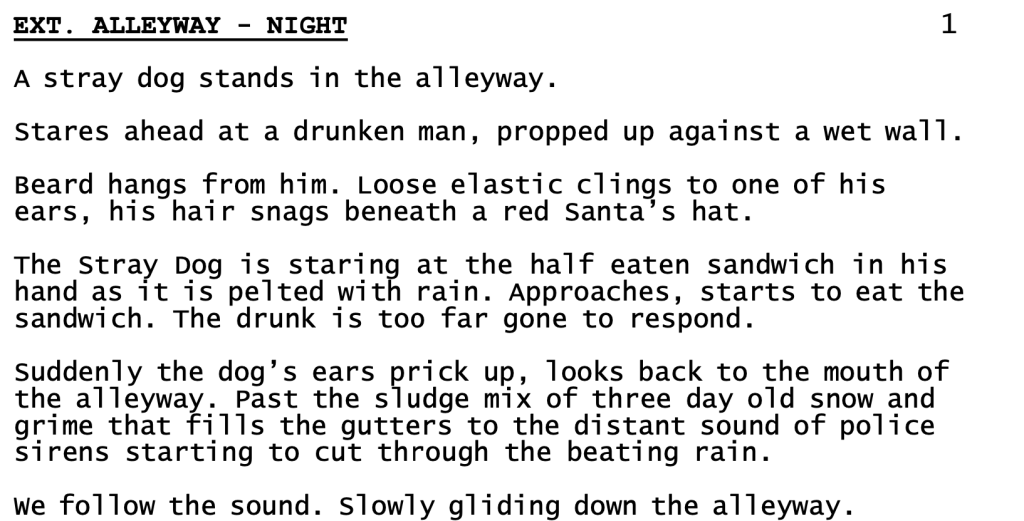Genre: Action/Crime
Premise: After a small time criminal tries to make a big time score, his drug deal goes massively wrong and he becomes the most hunted man in the city.
About: Today’s script comes from The Raid director Gareth Evans, who just signed a deal with Netflix. This is the first film on his slate and will star Tom Hardy.
Writer: Gareth Evans
Details: 117 pages
Wooop wooop. Wooop Wooop (these are alarm sounds, by the way). We have a ‘strange screenplay text’ alert. If anyone knows the name of the text in this script, please tell us in the comments. Because I can confirm this text is so scrunched together, the script is probably closer to 200 pages than 118. Not that Evans cares. Netflix seems to have given him carte blanche to do whatever he wants. But to all readers out there, this is a visual assault on the eyes not unlike the brutal ass beatings Evans’ movie characters put on each other. Make it stop!
We start off following 22 year old Charlie Beaumont and his girlfriend, Mia, a Bonnie & Clyde duo who have just stolen a bunch of cocaine-filled washing machines (yes, you read that right) and only escape the pursuing cops by throwing one of those washing machines out the back door of their truck, where it collides with the cop car’s windshield, nearly decapitating the policeman in the passenger seat.
Cut to Charlie and Mia entering the dark fortress of Tsui in Chinatown. Tsui practically runs the city. Just as Charlie and Mia are going to sell him the cocaine they stole, three dudes in hockey masks run in and kill Tsui and his entire gang. Charlie and Mia barely escape, having no idea that it was Tsui’s second-in-charge, Ching, who orchestrated the hit.
When the cops show up to the crime scene, including our hero, Walker, they check the limited security footage and see Mia and Charlie running away. It just so happens that Walker knows Charlie. And he knows he couldn’t have killed all these people. Doesn’t matter. All the cops think he did it. And the remaining members of Tsui’s Triad gang think so too, which means everyone is now out to either capture or kill Charlie and Mia.
Walker immediately heads to Charlie’s father, big time politician Lawrence Beaumont. Lawrence has so much dirt on Walker that he can put him in prison for life if he wants to, which has made Walker his lap dog for years. Lawrence tells Walker that if he doesn’t find and return a living Charlie to him before he’s slaughtered by either the cops or the Triad, then prison is exactly where Walker will be going.
Things get even dirtier when Tsui’s mother flies into town with her own personal army. She is going to find Charlie and Mia and make them suffer worse than any human being has suffered in all of history. Of course, Charlie and Mia didn’t kill Tsui. Ching did. Which is why Ching is also, secretly, running around town trying to find Charlie and Mia, so he can kill them and, in the process, bury his secret.
Eventually, Walker catches up with Charlie and Mia. He’ll need to escort them back to Lawrence while, seemingly, every person who’s ever committed a crime in this city is after them. Will any of the three survive???
You know, I didn’t like this one at first. It’s sort of one big action scene, which can be hard to read since you’re not really getting to know the characters that well. You could feel the reluctance bleeding through the page when Evans had to include some phone calls back to Walker’s wife, just to provide the tiniest bit of character development to the story (more on character development in a sec).
But as the script goes on, and you muscle your way through the intricate setup, you realize that the setup is actually pretty clever. And it’s clever because nothing is easy for anyone. If you want to quickly improve your screenwriting, make things more difficult on your characters. However difficult it currently is, make it more difficult than that. And not just for your main character. But for your villain. For your side characters. Everyone.
You have Charlie, who of course is being hunted by everyone even though he didn’t kill Tsui. You have Walker, whose boss wants him to capture Charlie. But he can’t capture Charlie because Lawrence has forced him to retrieve Charlie. You have Lawrence, who isn’t just trying to save his son, but also trying to hide the fact that his son stole drugs from one of *his* secret operations, which means Lawrence is on the hook if they discover where the cocaine originated. You have Ching, who secretly orchestrated all this, but now must outmaneuver Tsui’s more ruthless mother to kill Charlie so that Charlie doesn’t give up his secret. It feels like everybody’s goal is complicated. There’s nothing clean about each pursuit, which is how you want it.
Also, Havoc reminds us that a MacGuffin doesn’t always have to be a thing. It can be a person. In this case, the person is Charlie. For those of you who don’t know what a MacGuffin is, it’s the thing in the movie everyone is after. The great thing about MacGuffins is they create INSTANT ACTIVITY. Every single character becomes active since they’re all going after the MacGuffin. If you don’t have a MacGuffin, you’ll have to come up with individual goals for each character, which is a lot harder.
Another thing you’ll want to consider with action screenplays is to do what Evans does here, which is to focus on character interactions rather than character backstory. I think most writers believe that backstory = character development. They think characters have to monologue about some big event or death that happened in their past to truly convey who that character is.
But you don’t really want to do that in an action screenplay because action screenplays have to move. For that reason, you want to explore character through the conversations people have and let the reader fill in the backstory gaps themselves based on what those characters say.
For example, when Walker argues with Lawrence about capturing Charlie, you can throw in little bits and pieces of past between the two (“I’ve been covering for you for years”) without going into long-drawn out melodramatic exposition drops. In an action script, this passes for character development because we are learning about the characters through these interactions.
You can, of course, throw big long monologues in there. You can throw every writer’s favorite device in there – the dead kid backstory. But these moments are going to feel weird in an action movie because action movies need to move. And stopping everything to talk about some tragedy that happened 20 years ago is the opposite of movement.
Havoc takes some initial investment to appreciate. But once you’ve done the hard work of tracking all the main players in the first 30 pages, the script opens up and starts to have fun with everyone, zigging them and zagging them all over the city, throwing in the occasional twist and turn to keep you on your biggest and smallest toes. This is going to be a cool movie for Netflix.
[ ] What the hell did I just read?
[ ] wasn’t for me
[x] worth the read
[ ] impressive
[ ] genius
What I learned: Make things difficult for your characters, especially in action-crime movies, where cliches abound. For example, if all Walker had to do was catch Charlie and bring him into the station, that’s too standard. You need to make it more difficult. So, instead, Walker has to capture Charlie behind the cops back, then sneak him to his politician father without anyone knowing. That’s a lot more difficult than cuffing him and reading him his Miranda rights.



